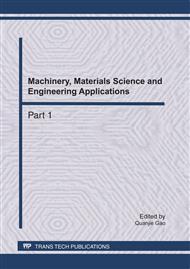[1]
S. Guruswamy, N. Srisukhumbowornchai, A. E. Clark, J. B. Restorff and M. Wun-Fogle: Scripta Mater. Vol. 43 (2000) No. 3, p.239.
DOI: 10.1016/s1359-6462(00)00397-3
Google Scholar
[2]
A. E. Clark, J. B. Restorff, M. Wun-Fogle, T. A. Lograsso and D. L. Schlagel: IEEE Trans. Magn. Vol. 36 (2000) No. 5, p.3238.
DOI: 10.1109/20.908752
Google Scholar
[3]
J. R. Cullen, A. E. Clark, M. Wun-Fogle, J. B. Restorff and T. A. Lograsso: J. Magn. Magn. Mater. Vol. 226-230 (2001), p.948.
DOI: 10.1016/s0304-8853(00)00612-0
Google Scholar
[4]
A. E. Clark, K. B. Hathaway, M. Wun-Fogle, J. B. Restorff, T. A. Lograsso, V. M. Keppens, G. Petculescu and R. A. Taylor: J. Appl. Phys. Vol. 93 (2003) No. 10, p.8621.
DOI: 10.1063/1.1540130
Google Scholar
[5]
T. Ueno, E. Summers and T. Higuchi: Sensor. Actuat. A. Vol. 137 (2007), p.134.
Google Scholar
[6]
T. Ueno, E. Summers, M. Wun-Fogle and T. Higuchi: Sensor. Actuat. A. Vol. 148 (2008), p.280.
Google Scholar
[7]
I. S. Golovin, H. Neuhäuser, A. Rivière and A. Strahl: Intermetallics Vol. 12 (2004) No. 2, p.125.
Google Scholar
[8]
Z. C. Zhou, F. S. Han and Z. Y. Gao: Acta Mater. Vol. 52 (2004) No. 13, p.4049.
Google Scholar
[9]
I. S. Golovin, S. B. Golovina, A. Strahl, H. Neuhäuser, T. S. Pavlova, S. A. Golovin and R. Schaller: Scripta Mater. Vol. 50 (2004) No. 8, p.1187.
Google Scholar
[10]
C. Azcoitia and A. Karimi: J. Alloy. Compd Vol. 310 (2000), p.160.
Google Scholar
[11]
A. Karimi, C. Azcoitia and J. Degauque: J. Magn. Magn. Mater. Vol. 215-216 (2000), p.601.
Google Scholar
[12]
W. Wang and B. Zhou: Mater. Sci. Eng. A Vol. 366 (2004) No. 1, p.45.
Google Scholar
[13]
Z. Zhou: Mater. Sci. Eng. A Vol. 472 (2008) No. 1-2, p.166.
Google Scholar
[14]
Y. Watanabe, H. Sato, Y. Nishino and I. Kim: Mater. Sci. Eng. A Vol. 490 (2008) No. 1-2, p.138.
Google Scholar
[15]
Y. Watanabe, H. Sato, Y. Nishino and I. Kim: Mater. Sci. Eng. A Vol. 521-522 (2009), p.376.
Google Scholar
[16]
M. Ishimoto, H. Numakura and M. Wuttig: Mater. Sci. Eng. A Vol. 442 (2006) No. 1-2, p.195.
Google Scholar
[17]
J. San Juan, M. L. N, J. Lacaze, B. Viguier and D. Fournier: Mater. Sci. Eng. A Vol. 442 (2006) No. 1-2, p.492.
Google Scholar
[18]
A. S. Nowick and B. S. Berry: Anelastic Relaxation in Crystalline Solids, (Academic Press, New York 1972).
Google Scholar
[19]
I. S. Golovin, S. B. Golovina, A. Strahl, H. Neuhäuser, T. S. Pavlova, S. A. Golovin and R. Schaller: Scripta Mater. Vol. 50 (2004) No. 8, p.1187.
Google Scholar
[20]
V. A. Udovenko, I. B. Chudakov and N. A. Polyakova, in M3D III: Mechanics and Mechanisms of Material Damping, Edited by: A. Wolffenden, V. K. Kinra, ASTM, Philadelphia 1997, 204.
DOI: 10.1520/stp11749s
Google Scholar
[21]
O. Ikeda, R. Kainuma, I. Ohnuma, K. Fukamichi and K. Ishida: J. Alloy. Compd Vol. 347 (2002), p.198.
Google Scholar


